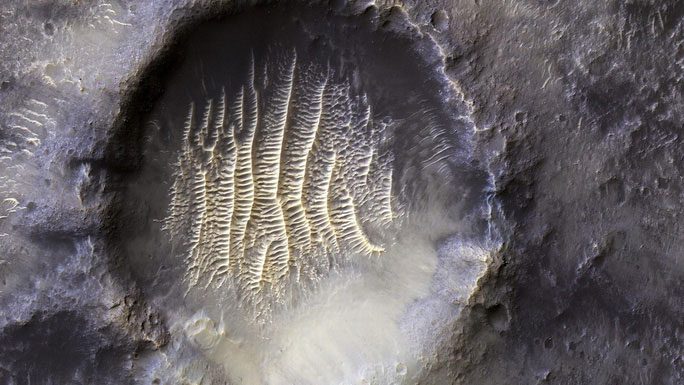“Fingerprint” refers to the strange glowing ridges mentioned above, which is a depression named Airy-0. It may be a crater formed by impact, nestled within a much larger crater called Airy, which has a diameter of up to 43.5 km, dominating the surface of Mars.
The newly released image was captured by the Mars Reconnaissance Orbiter on September 8, 2021, using a camera known as the “High-Resolution Imaging Science Experiment” mounted on the spacecraft.
According to Live Science, Airy-0 has also been selected by NASA as the marker for the prime meridian (0 degrees longitude) on Mars.

“Strange fingerprint” on Mars – (Photo: NASA)
Previously, the larger Airy crater, which could be an ancient volcano or an impact crater, was chosen as the prime meridian marker. However, due to its size, scientists have always sought a smaller feature to ensure more accurate alignment measurements.
The name “Airy” is derived from the English astronomer Sir George Biddell Airy, who constructed a telescope at the Royal Observatory in Greenwich, which is also the reference point for the prime meridian (0 degrees longitude) on Earth.
Planetary scientist Abigail Fraeman, deputy project scientist for Curiosity—the long-standing Mars rover from NASA—explained that the “fingerprint” structure consists of transverse ridges formed by windblown sediment (TAR), essentially a wind-sculpted structure on Mars created over many years. Scientists have encountered TAR in other craters on Mars.
This unusual structure is formed by sand dunes covered with a thin layer of dust, likely hematite, a mineral rich in iron oxide. This dust has high reflectivity, making the TAR stand out with its sparkling edges.
This is not the first time bizarre and striking structures have been found on another planet, especially Mars, where spacecraft can easily access the surface.
According to Space, on March 30, the European Space Agency (ESA) also shocked the public by releasing images of a pair of craters with terrain resembling human brains.





















































